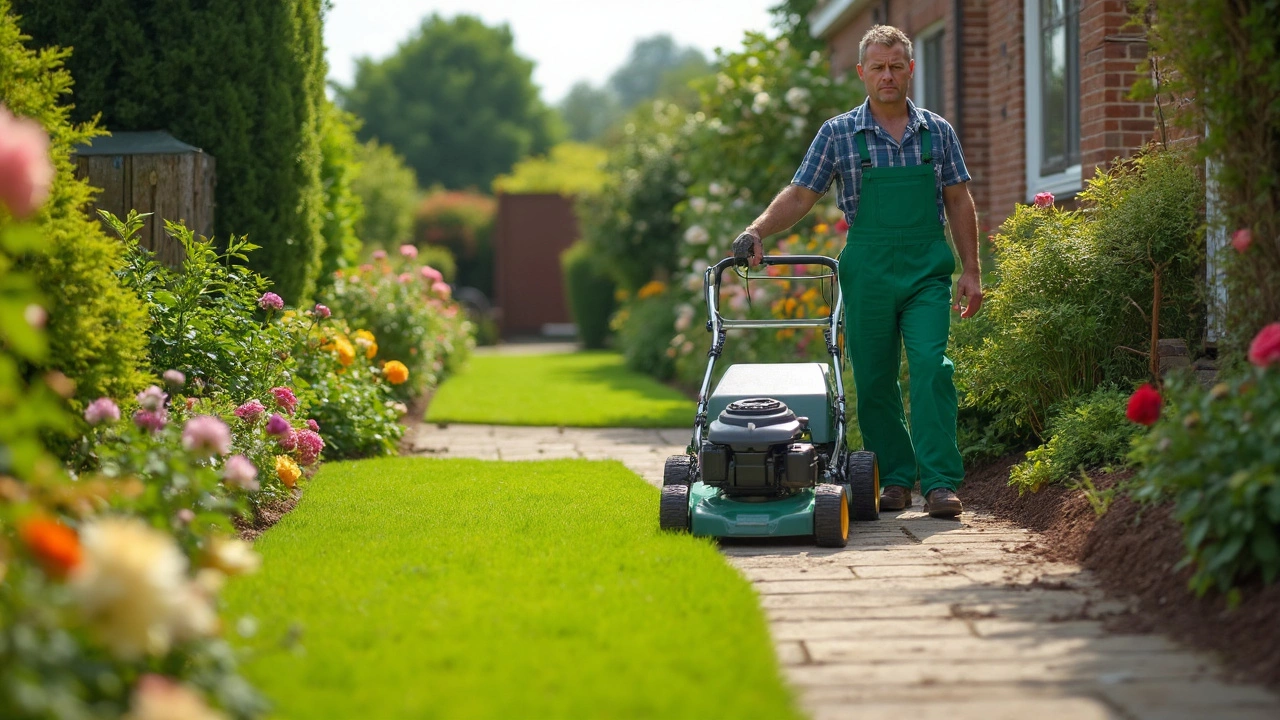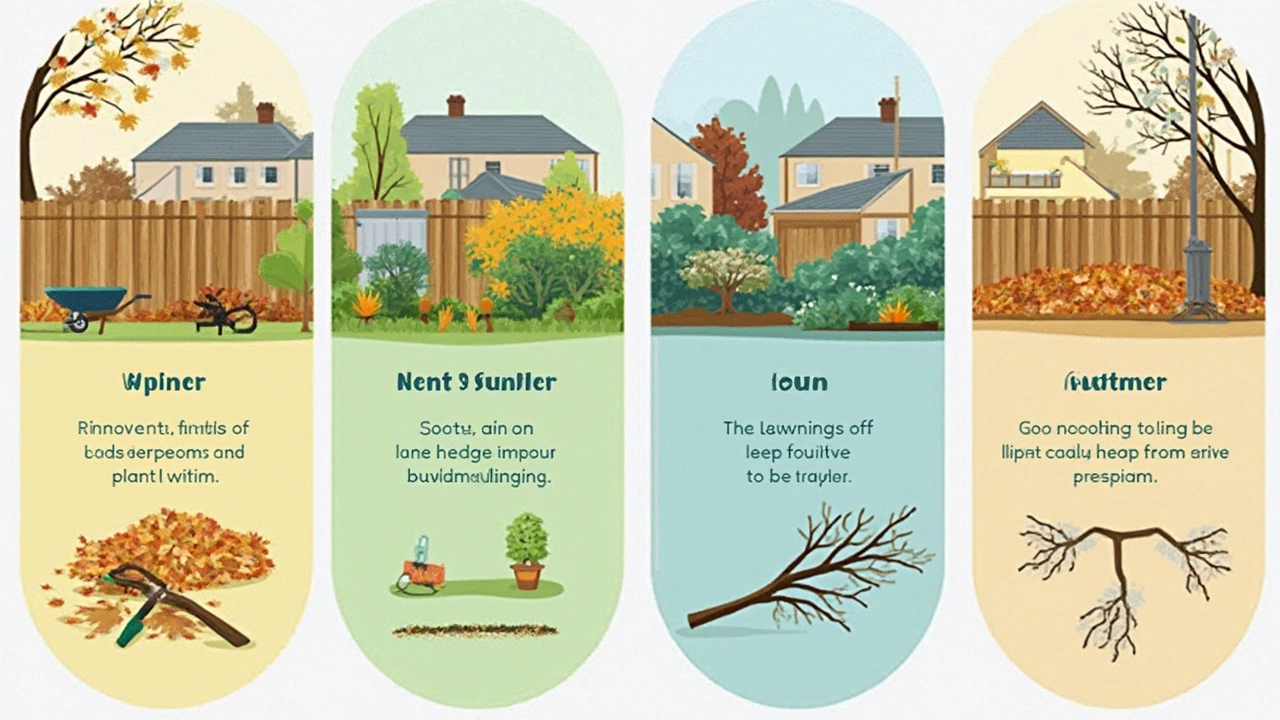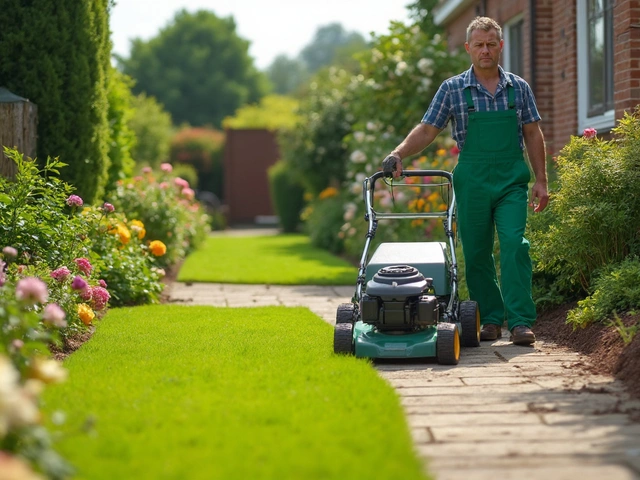Yard Work: What Does It Really Include?

The phrase 'yard work' gets tossed around a lot, but what does it actually mean? For most folks, it starts with mowing grass and pulling weeds. But there's way more on that list. If you're thinking about hiring a landscaping crew or just want to get your own yard in shape, it helps to know exactly what's included.
Yard work usually covers the essentials like cutting the grass, raking up leaves, clearing sticks and trash, and trimming the edges near sidewalks or flower beds. Regular jobs also include basic weed control and watering—especially during dry stretches. These tasks are the bread and butter of any tidy outdoor space, keeping things manageable before anything gets out of hand.
- Breaking Down the Basics
- Beyond the Lawn: Extra Services
- Tips for Smarter Yard Work
- How to Choose What You Need
Breaking Down the Basics
If you ask ten people to name the biggest parts of yard work, you'll probably hear 'mowing' every single time. Keeping grass trimmed is the core of yard work, and it needs to be done regularly to keep your place looking sharp and prevent weeds from taking over. One pass with a lawnmower every week or two really keeps things under control.
Next up is edging. This is what makes a yard look clean around garden beds, walkways, and driveways. Edging stops grass from creeping into places it doesn't belong, and it's often done with a string trimmer or a manual tool once a month, or even more often if you're serious about curb appeal.
You can't forget about leaf and debris cleanup. When leaves pile up in the fall—or if twigs and trash blow in—stuff can get messy fast. Most folks rake or use a leaf blower to clear things away. It's not just for looks, either: thick layers of leaves can kill grass and become a home for bugs.
Weed control is another basic. Pulling weeds by hand, using a hoe, or applying safe weed control products all work. The goal is simple: keep flowerbeds, walkways, and lawns weed-free so the good plants don't have to compete for space, sun, and water.
Watering may sound obvious, but it's huge. Grass and garden plants won't survive the hotter months without some help. Whether you stick to hand-watering or install sprinklers, it's all about giving the yard what it needs when rain isn't enough. Remember, overwatering is just as bad as underwatering—grass usually likes an inch of water each week.
- Mowing: Weekly or biweekly, depending on the season
- Edging: At least once a month for sharp lines
- Leaf/debris cleanup: As needed, but especially in the fall
- Weed control: Every couple of weeks
- Watering: About once a week or more during hot weather
Tackling these basics goes a long way—skip them for a few weeks and you'll notice.
Beyond the Lawn: Extra Services
Once you’ve got the basics handled, it’s easy to see that real yard work goes well past just mowing and raking. There’s a whole menu of extras you can tack on, depending on what your yard needs and how polished you want things to look. If you want your yard to look as good as those pro magazine spreads, pay attention to these add-ons.
Trimming shrubs and hedges makes a huge difference. When bushes start looking shaggy, a quick trim keeps everything neat—and helps plants grow better. Most landscapers bring out electric trimmers to get clean lines, but you can handle small jobs with plain old handheld shears.
Mulching is another big one. Tossing down a fresh layer of mulch around your plants isn’t just for looks. Mulch locks in moisture, keeps weeds down, and even protects roots from sudden temperature swings. Most folks swap out old mulch in spring or fall since it breaks down over time.
Then there’s fertilizing and aerating the lawn. Feeding the grass at the right time—usually spring or fall—makes lawns thick and green. Aeration, where they poke holes in the soil, helps water and nutrients get down to the roots. If you’ve got heavy clay soil or pets running around, aeration really matters.
Don’t forget about planting and seasonal cleanup. Spring and fall always bring piles of dead leaves, twigs, or even branches from storms. A proper yard work session can mean hauling all that junk away, planting new flowers or shrubs, and sometimes even laying down new sod if your grass is shot.
- Trimming shrubs and hedges
- Mulching beds and tree rings
- Fertilizing and aeration
- Planting seasonal flowers, shrubs, or grass seed
- Removing leaves, branches, and debris
If you’re hiring a service, always ask what’s standard and what counts as extra. Some folks pay just for mowing and don’t realize things like mulch or bush trimming cost more. It’s better to ask than get surprised by an extra bill later.

Tips for Smarter Yard Work
Tired of spending your whole weekend sweating over your yard? You don’t have to. Getting a better handle on yard work is about working smarter, not just harder. Here’s how you can save time, money, and even your back—without skimping on results.
- Time It Right: Early morning or late afternoon is best for mowing and heavy work, especially in the summer. Grass won’t dry out as fast, and you’ll dodge the midday heat.
- Sharpen Your Tools: Dull mower blades tear grass instead of cutting it, leading to brown tips. Sharpening just twice a season can boost lawn health and cut mowing time.
- Use Mulch to Your Advantage: A layer of mulch (about 2-3 inches) keeps weeds down and holds moisture, so you water less. Plus, it keeps soil temps more stable.
- Mow High, Not Low: Don’t scalp your lawn—set your mower higher (3-4 inches for most types). Taller grass shades soil, stopping weed seeds from growing and cutting down how often you have to water.
- Batch Your Tasks: Keep edging, mowing, and trimming to one day instead of spreading over the week. This makes your yard look neater, longer, and saves set-up time.
And if you want some numbers to back all this up, here’s what the experts say about common yard chores:
| Task | How Often | Average Time/Visit |
|---|---|---|
| Mowing | 1x per week (growing season) | 30–60 min |
| Leaf Raking | As needed, fall | 45–90 min |
| Weed Control | Every 2 weeks | 30 min |
| Mulching | 1–2x per year | 2–3 hrs |
One more handy tip: If allergies hit you hard, wear a mask while mowing or raking—it actually helps! Lots of people miss this quick fix. Bottom line, a little planning and the right techniques go a long way when it comes to keeping your yard looking its best without draining all your free time.
How to Choose What You Need
If you want to get your yard work handled right, first take a good look at what you have. Is your grass uneven? Are weeds popping up everywhere? Maybe your bushes are taking over the sidewalk. Everyone's yard has different needs, so knowing what to focus on saves time and cash.
Start with a simple checklist. Jot down the things that bug you most—dead patches in the lawn, overgrown shrubs, leaves piling up, or beds that need fresh mulch. A quick walk around the yard can show exactly what needs work. Don't ignore stuff that's easy to miss, like clogged gutters or dying plants. These can cause bigger headaches later.
- If yard work feels overwhelming, break things down by season. For example, spring usually needs more cleanup from winter debris, while summer's about keeping up with mowing and water.
- Be honest about your schedule. If you only have a few free hours a month, it's best to get help with bigger jobs like tree trimming or complex landscaping.
- Prioritize safety tasks first, like clearing branches near your roof or spots that look slippery.
Cost is another big factor. Americans spend an average of $500 to $700 a year on yard and landscaping services. If your budget is tight, stick with essentials like mowing and leaf removal, and save upgrades for later.
| Yard Size | Typical Weekly Tasks | Estimated Cost/Month |
|---|---|---|
| Small (under 1,000 sq ft) | Mow, edge, weed | $60 - $120 |
| Medium (1,000—5,000 sq ft) | Mow, trim, weed, light pruning | $120 - $250 |
| Large (over 5,000 sq ft) | Full mowing, edging, garden care, tree/shrub care | $250 - $500 |
If you're hiring help, ask lots of questions. Some companies only mow; others handle mulching, cleanups, even fertilizing. Check for services that fit what you need now, but can also handle surprises—like a thunderstorm dumping branches all over your yard.
Want to save money or like getting your hands dirty? Figure out what you're comfortable doing, and leave the rest to the pros. You might mow yourself and hire out the heavy lifting come fall cleanup.

